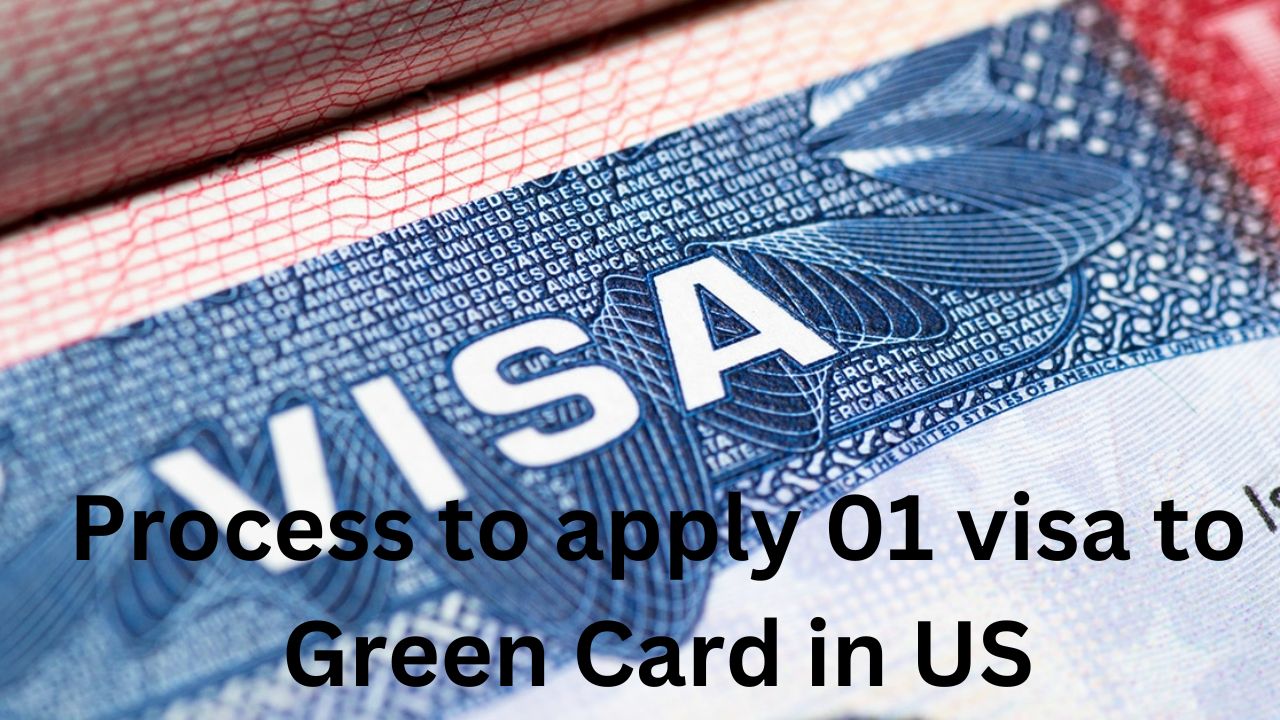Process to apply 01 visa to Green Card in US
Process to apply 01 visa to Green Card in US
In contrast to other temporarily US Work visas however, the O-1 visa gives holders the chance to obtain an green Card. This can be done through submitting an application to switch your status from an O-1 and become a permanent citizen, as long as you are able to meet requirements for Green Card eligibility requirements.
How do I you should apply for the Green Card?
The O-1 visa only grants temporary permission to work in US.
The validity of the visa granted by the route O-1 is usually determined by the amount of time required for the holder of the visa to conduct their work for the employer that petitions them for the maximum which is 3 years. In order to remain in the US beyond this time, extensions are required. Three years are quickly rearranged especially given the lengthy nature of the petitioning for visa extensions procedure.
The three-year age limit may restrict the number of job opportunities compared to the security in Green Card status preferred or anticipated by employers.
The process of re-entering the US using an O-1 visa isn’t always easy and you could be asked inquiries from border officers.
An Green Card removes the requirement to go through the process of extension in order to extend your O-1 Visa regularly. Therefore, being a permanent resident can be an attractive and beneficial option for those who hold an O-1 visa considering an extended stay within the US. With exceptional skills or achievements in their chosen professional sector, it makes sense to the US to offer O-1 visa holders to have the opportunity to be permanent residents, and to remain in the US and contribute to the US society and economy.
If you have US permanent residency Your legal status will be permanent and you will not be required to apply for an extension of your visa. You are entitled to rights like access to education, home finance and the right to be a naturalized US citizen In most cases after five years. Citizenship confers exactly the same rights and privileges as US citizens; you are able to vote, and if you are convicted of any crime, you would not be deported.
What is “dual intent”??
This O-1 visa is classified as a dual-intent visa, which means that those who have it are not penalized when they apply for the Green Card while they are in the US on a nonimmigrant visa. This is a significant distinction as the eligibility requirements for nonimmigrant visas usually will require applicants to show that they intend to depart their home country of the US at the time the visa expires for example, if they want to keep the residence of their country of origin.
That means that if you have a an O-1 visa in good standing You can show intent to remain in the US for a long time while living there for a short period, and then apply for a change in status without affecting the status of your nonimmigrant.
Green Card conditions
It is necessary to obtain the Green Card, also known as a permanent residency card, to be able to live as well work within the United States indefinitely, without any restrictions on immigration.
There are many possible routes to obtain getting a Green Card for example, by working or employment. The process for applying and eligibility requirements depend on the type of Green Card you’re applying for.
The EB-1 classification is used for Green Card applications from workers that are in three categories:
- EB-1A: Extraordinary capability
- Excellent researchers and professors
- Eb-1C: Multinational manager executive
The name implies as the name suggests, it is the EB1 classification for those who hold an O-1 visa is via an EB-1A class.
O-1 to EB-1A
The EB-1A classification is a set of standards for all professions, regardless of O-1A and O-1B status. Just as the O-1 visa demanded proof of the applicant’s achievements and extraordinary abilities in their chosen area of sciences, arts, education or business and applicants with EB-1A status be able to demonstrate their achievements and exceptional ability.
To be eligible under EB-1A to be eligible, you must be able to demonstrate that you are eligible under two criteria:
Preliminary ‘Objective’ Test
It is required to provide evidence that proves that you’ve been awarded a single achievement , like the Olympic medal , or Nobel prize, or that you have at minimum three of the requirements for evidence of extraordinary talent in your field of expertise:
- The evidence of receiving less internationally or nationally acknowledged awards or prizes for the highest level of excellence
- Your evidence of affiliation to organizations in the field that have a high expectation of their members
- You have evidence of publications about you in major or professional trade publications, or in other important media
- You have evidence that you’ve been asked to assess the work of other people, either as an individual or as part of a panel
- Your original research, scientific or athletic, artistic, or business-related contribution of significant importance to the field
- The evidence of your authorship in academic articles in trade journals of a professional or major trade publications, or in other significant media
- The evidence that your work has been displayed in art exhibitions or in showcases
- Your performance in an essential or leading part in a prestigious organization
- The evidence that you are able to command an impressive salary or substantial remuneration in comparison to other professionals in the area
- The evidence of your commercial success within the arts of performing
Subjective Final Merits Determination
A Final Merits Determination determines your standing as one of the top people in your field :
- “one of the small portion that has made it to the highest level of effort” and
- You have been awarded “sustained worldwide or national acclaim” as well as that “achievements were recognized within your field of your expertise”.
The definition of a specialization that is narrow enough yet reliable is essential to composing a compelling argument and proving your place in the top position of that field.
Additionally, applicants for EB-1A must also prove that their work will bring significant benefits for the US.
Supporting documents Green Card
While the eligibility requirements are similar for O-1 as well as EB-1A visas, those applying need to take note that the quality of documentation required to be submitted for Green Card Green Card is notably higher than that of the O-1 visa “extensive documents” is required to be provided.
Obtained O-1 visa status doesn’t mean that an EB-1A visa can be granted. The EB-1A application will be evaluated and ruled on its merits and independent of any prior successful O-1 visa application.
Therefore the Green Card application must be thorough and persuasive to prove your claim. The application will require significant supporting documents to be collected and submitted to demonstrate your eligibility. These include records of your accomplishments that prove you are able to meet the extraordinary in your field by gaining continuous international or national recognition and the extent to which your work is beneficial for the US. The documents mentioned in the guideline are not comprehensive, but should you be able to provide moreinformation, in order to provide ‘over-evidence’, it is preferred to prove that you’re proving that you are an exceptional expert in your field.
Consulting a professional can aid in shaping your proposal to meet the requirements that the adjudicators are searching for.
How do I go from an”O-1″ visa Green Card
It involves changing the the visa status from immigrant into an immigration.
The Green Card application can be submitted by self-petitioning or an approved petition from your employer. The EB-1 applicant is able to self-petition based on their status.
To change the O-1 classification to an classification EB-1A, the first step is to file the form I-140 at USCIS. In the I-140 the petitioner needs to provide the reasons why you (as as the recipient) are eligible and qualify to receive the Green Card.
The petition must also include evidence from the document that you meet the criteria (as as above).
When you have received your form I-140 is accepted Your priority date will become current. In this phase of the process, you’ll need to submit form I-485 to USCIS from outside the US in order to change or convert you status to change from not immigrant (O-1) to immigration (EB-1A).
If you are a citizen of the US You will be issued a separate travel and employment authorizations from USCIS when the adjudication process is completed.
It is possible to file Form I-140 and Form I-485 simultaneously to reduce time.
In contrast to the O-1 visa , which is the initial visa for the visa and an extension process, you’re in no way required to sponsor a qualified US employer to be eligible for the EB-1A. It is also not necessary to obtain the PERM Labor Certification.
If, however, you are employed by your company that is sponsoring the application you must prove you have tried all other options for hiring in the US local labor market and also that you are eligible to be granted an visa to enter the country. Employers must be required to get an approved labor certificate by the Department of Labor. This document demonstrates that the business could not find the services of a U.S. worker for the task.
If you are applying from abroad you will need to complete an Green Card application at a US consular office overseas in order to complete Form DS 260 (Immigrant Visa Electronic Application) prior to taking part in the Green Card interview at the US consulate or embassy of your country.
The visa will be issued once the USCIS accepts the Form I-485 or DS number 260.
From O-1 visas for Green Card processing times
The typical processing time for an EB-1 application ranges from six to twelve months, but certain factors like USCIS case loads as well as pandemic-related delays in service and problems that affect the petition may cause delays.
It is also worthwhile to determine whether premium processing is available while completing your application.



